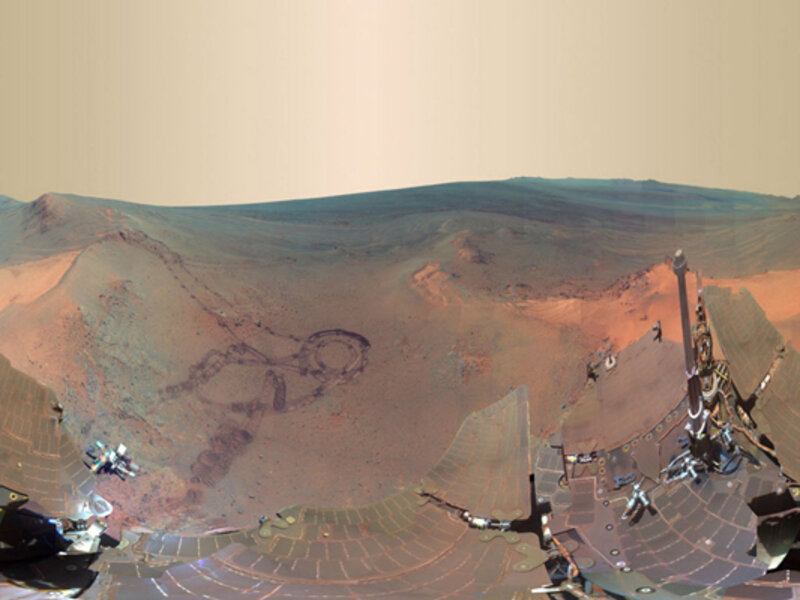Do dark streaks on Mars indicate the flow of water?
Loading...
The hunt for liquid water reaching the surface of today's Mars has yet to yield a drop, but evidence is building that water may lurk just beneath the surface in a handful of locations.
The latest signs come from 13 areas along Mars' southern mid-latitudes, where observations from NASA's Mars Reconnaissance Orbiter (MRO) have revealed chemical signatures on the surface that intensify during the warm season and fade when winter returns.
These signatures line up with images that MRO's HiRISE camera has captured of dark streaks on slopes in the same areas. The streaks gradually move down from outcrops of bedrock and retreat with the waxing and waning of the warm season.
In 2011, scientists announced the discovery of 19 confirmed or likely sites where the dark streaks appeared, with another 20 candidate sites in need of additional observations.
Previously, scientists had discovered surface features that initially looked as if they could have been formed by recent releases of water flowing downslope. But others noted that the features – essentially dry sediment flows – could just as easily have formed from mini landslides, perhaps triggered by the flash-thawing of carbon-dioxide ice into a gas, which then burst through the surface and triggered the slide. Or wind-driven sediment could have accumulated near the top of the slopes, finally sliding downhill after so much silt and dust built up that it no longer could resist gravity's tug.
Not so for these dark streaks, suggests Lujendra Ojha, a graduate student at the Georgia Institute of Technology in Atlanta and the lead author of the paper reporting the new results in the journal Geophysical Research Letters.
"Normally when you come up with something new in science, there's always a controversy" as researchers test the validity of the observations as well as assertions of what they mean, he says. With the discovery of the dark streaks, "no one has come out with a hypothesis that can explain these features without water. It's a very hard thing to explain without water."
Indeed, in a paper accepted for publication in the journal Icarus, Mr. Ojha and colleagues say these dark streaks represent "a unique phenomenon on Mars," unlike other recent flow features at other latitudes with water-free causes.
Even so, evidence that water is involved remains circumstantial. Most of the streaks detected so far appear in southern mid-latitudes on steep slopes that face Mars' equator. Others have appeared on steep slopes along the equator itself. Over several seasons, researchers have observed the pattern of the streaks growing when it's warm and retreating when it's cold. The streaks are oriented downhill, and they are darker than surrounding surfaces.
This prompted Ojha and colleagues to hunt for the smoking gun – the chemical fingerprint of water itself in these features. For this task, they turned to MRO's Compact Reconnaissance Imaging Spectrometer for Mars (CRISM).
Unlike the HiRISE camera, which can cover a patch of Mars about 10 inches across with each of the camera's more than 1 billion pixels, CRISM can cover about 60 feet per pixel. The individual dark streaks range from 1.6 to 16 feet across, making them difficult for CRISM to pick out individually.
Fortunately, the streaks tend to be bunched together, often merging where their flows end at the bottom of the slopes. This gave CRISM features large enough to yield meaningful measurements.
The hunt for direct evidence of water came up short, Ojha acknowledges. Instead, CRISM identified iron-bearing minerals in the streaks. The spectral signatures of these minerals intensified and weakened compared with their wider surroundings as their locations warmed and cooled with the seasons.
This intensification could result from water sluicing finer-grain silts away from heavier, coarser mineral grains, exposing more of these grains to CRISM. Water dampening the surface also would intensify the signatures of these minerals. Or water flowing downslope could increase the abundance of the iron-bearing minerals.
Without direct evidence of water, however, the researchers also acknowledge other processes that could be at work. Wind, rather than water, could drive finer sediments from the larger grains, for instance.
If water is present just below the surface to flow downslope, it could well be brine that includes ferric sulfates – a salt that serves as antifreeze, Ojha says. Ferric sulfates allow water to remain liquid at temperatures as low as minus 90 degrees F. Once on the surface, however, the water would evaporate very quickly.
Indeed, Ojha suggests, one reason the team failed to find water in these streaks could be the time of day during which MRO observes the southern mid-latitudes. MRO passes overhead at about 3 p.m. each day Mars time. Assuming water begins to make its appearance in the morning, by late afternoon most if not all of it would have evaporated, leaving just the darkened streaks.
CRISM is able to detect the water if it's there, Ojha says. It may take a mission designed to make two orbits of Mars each day, however, to catch water on the surface.








